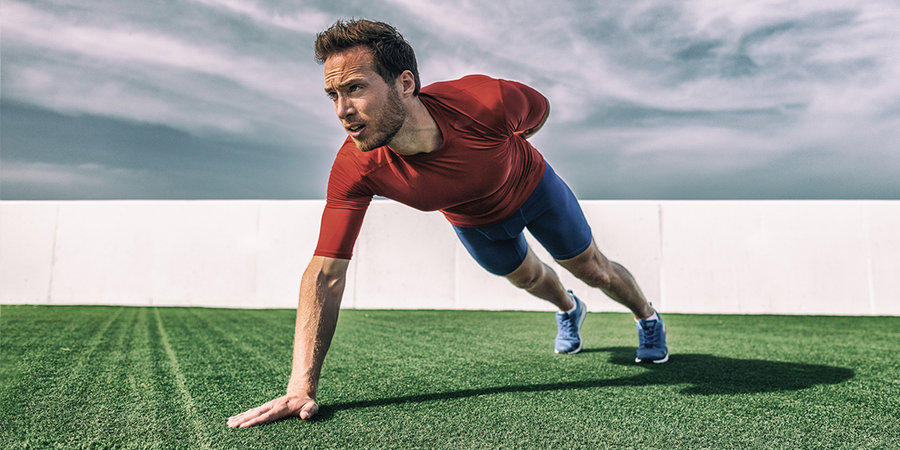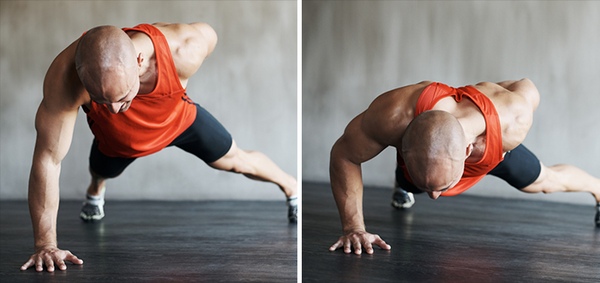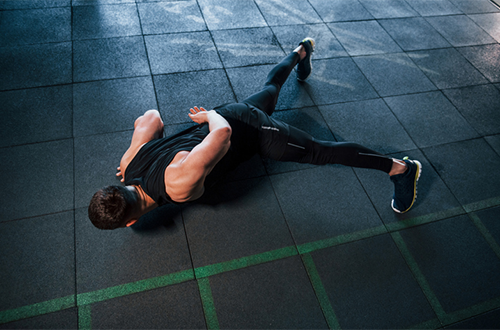
How to Master the One-Arm Push-Up
By Jenessa Connor
Dropping into a set of one-arm push-ups sends a few different messages, the first of which is that you have upper-body strength for days. Secondly, you're not afraid to put in the work; learning how to do a one-arm push-up takes balance, coordination, and tons of practice. And, lastly… you're kind of a show-off.
We get it. A one-arm push-up is an accomplishment that deserves celebration. So, if you've got single-arm push-ups in your repertoire, go ahead and flaunt them.
But, if doing a one-arm push-up is one of the training goals that you've struggled to meet, we've got a plan to help you get you there.
Tackle your toughest workouts with extra energy and focus with LADDER Pre-Workout.
.
How To Do a One-Arm Push-Up

- Assume a push-up position with your shoulders stacked over your wrists and your feet slightly wider than hip-width apart. Keep your body straight from head to feet.
- Maintaining tension throughout your body, lift your right hand off the floor and bring it behind your back.
- Bend your left elbow to lower your body toward the floor.
- Press away from the floor to return to the starting position.
- Perform equal reps on both arms.
.
Tips for Doing One-Arm Push-Ups

Feeling ready to try your hand at the one-arm push-up? Braun offers some tips for doing the exercise safely and effectively.
1. Build Your Base
If you attempt a one-arm push-up before you're ready, you'll just end up frustrated (or, worse, injured).
"I would recommend a base level of 30 unbroken push-ups before graduating to a version of the one-arm push-up," Braun says. "There is a big jump between one- to two-arm push-ups, so you should have good upper-body strength before attempting."
2. Progress Gradually
Better yet, try a couple (still challenging) push-up variations before going all-in on one arm.
"I would suggest starting with a 1.5-arm push-up, also known as the archer push-up," Braun says. "In this variation, you place about 75% of your weight into one arm while the other still assists."
Once you've become proficient in archer push-ups, Braun suggests moving on to an elevated one-arm push-up, in which you're feet are on the floor and your hand is on something like a bench or box. "The higher the surface and the wider the feet are, the more accessible it will be," he says.
3. Use Irradiation and Torque
"One of the best tips for effectively nailing the one-arm push-up is to create full-body tension, also known as irradiation," Braun says. "By irradiating, you can create full stability, which will aid in the total strength output."
"Another key is to focus on creating torque (a twisting force) through the planted arm by corkscrewing [the palm] into the floor," Braun says. Rotating the arm away from your midline can help you maintain your balance and increase stability.
4. Don't Expect Perfection
As with learning any new skill, mastering one-arm push-ups takes time and practice. "It's important to understand the first batch of reps might not be pretty, and that is okay," Braun says. "Over time, you will clean up your form." So stick with it, but go easy on yourself.
Braun also notes that you might feel stronger on one side than the other. "That is okay because one of the benefits in unilateral training is decreasing that strength deficit," he says. Practicing one-arm push-ups can be a great way to "even things out."
.
Benefits of the One-Arm Push-Up
Besides an ego boost and plenty of gym cred, one-arm push-ups offer real health and fitness benefits. Just like standard push-ups, the single-arm version builds strength in the arms, chest, shoulders, and core while getting your heart pumping. But, for those who can crush rep after rep on two hands, the single-arm push-up presents an even more significant challenge.
"One-arm push-ups are great for advanced exercisers who want to continue building strength with just their body weight," says Cody Braun, NASM performance enhancement specialist.
By taking one arm out of play, you don't just increase the load of the working arm. You also make your base of support smaller and add an element of instability. The one-arm push-up is an intense strength exercise and a balancing act.
It will also reveal any upper-body deficiencies. In a standard push-up, it's easy to compensate for a "weak" side; you simply push harder with the strong side. Working one arm at a time will force you to focus on strengthening the muscles that need the most attention.



